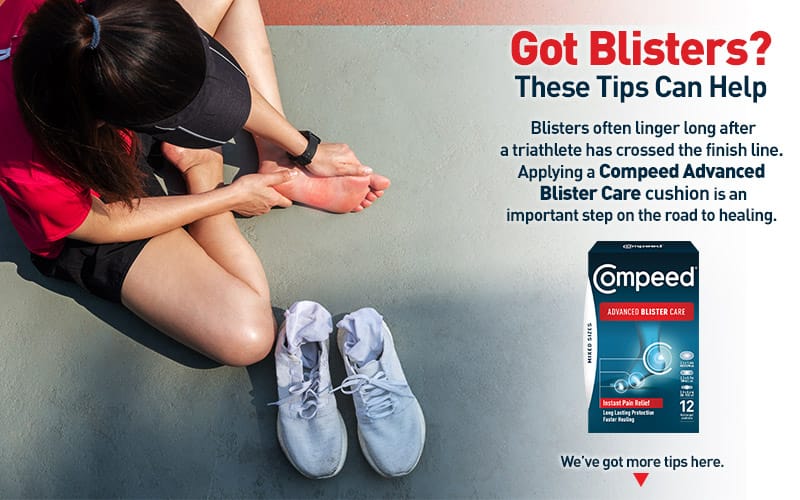
Blister Relief Starts Here!
by Compeed

Whether the recent triathlon was your first or last -- maybe both -- or somewhere in between, your body is still recovering from the beating it took. Your feet, in particular, might still be screaming.
Often worse than the familiar aches and pains that follow an intense competition is the lingering, burning and oozing sensation of a blister. Triathletes get blisters because of the continuous rubbing of running or biking shoes and socks against skin. This causes a friction blister, which is the most common type of blister. The upper layer of skin actually shears away from the lower tissue and forms a pocket that fills with plasma-like fluid. This fluid helps the skin regenerate and provides an extra layer of protection to reduce or prevent additional friction at the wound.
How Bad Is Your Blister?
Maybe you are waiting for your blisters from your recent race to heal on their own -- something that definitely happens, but as you now realize, often there is discomfort or even pain during that wait. And the more time a blister goes untreated, the more likely it is to get infected. Common signs of infection are yellowish pus that is thicker than normal blister fluid, increased pain, swelling, redness, warmth or red streaks extending from the blister. If you suspect infection, seek medical attention immediately. Do not pass Go, do not collect $200.
If, however, your blister is just kinda hanging around, there are ways to make it go away for good. Or at least until your next triathlon.
- Clean and Inspect
Before treating your blister, wash your hands with soap and warm water to avoid introducing any bacteria to the wound. Inspect the area for warmth, swelling, foul smells, pus, pain, holes or peeling skin. Remember: Seek medical attention if you think your blister is badly infected.
- To Pop or Not to Pop
If you’re confident you don’t need medical help, clean the wound well. Warm soapy water is ideal, but you can also use an antiseptic or even salt water. In fact, if possible, soak your foot for 10 minutes in a salt-water bath. Resist the urge to pop the blister. Although that was common practice not so long ago, blister drainage is no longer recommended because it can cause an infection. However, if a blister is large, painful or likely to be further irritated, it could be better to drain it in order to relieve pain or prevent accidental tearing of the roof, or top layer. If you determine this is necessary, or the blister bursts on its own, don’t pull off any skin.
- Keep It Clean
Again, clean the area. Then cover it with a specialist bandage such as Compeed Advanced Blister Care, which has hydrocolloid gel to absorb excess moisture, cushioning to ease pain and protect skin, and secure adhesion to keep the area clean while your body’s natural wound-healing process does its thing.
- Keep It Covered
A common mistake is to remove a blister bandage at night to let air get to the wound. Don’t do it! The liquid around a blister contains important cells needed for natural wound healing. Allowing blisters or other skin wounds to heal in open air, or covering them with an ordinary bandage, dries the wound, forming a scab. This approach slows the healing process, as the cells needed for wound healing grow more slowly in a dry environment. It’s also possible to end up with a scar after the scab falls off. Instead, cover it with Compeed.
- Plot Twist
There is one notable exception to the keep-it-covered advice, and that is when the top layer comes off. This is also known as the blister being deroofed. In that situation, a Compeed cushion can be changed when the white bubble that forms from the blister fluid reaches the edge of the cushion. But a new cushion should be applied immediately.
The Better Option
Compeed cushions are specially designed to provide a moist healing environment for your tender skin. They provide three times more cushioning and 10 times more pain relief than ordinary bandages, and 20% faster healing. Compeed cushions -- also known as blister plasters -- are waterproof, sweat-resistant and hypoallergenic. They aren’t going anywhere until the wound heals.
- Compeed FTW
The main objective in treating blisters is to keep the blister intact for as long as possible, because the skin provides a natural protection against infection. The primary goals of treatment, then, should be to prevent expansion of the lesion, reduce discomfort, promote healing and prevent infection. Compeed Advanced Blister Care does all that and more. So as your body continues to recover from the extreme exertion of your recent race, don’t forget about your feet. And have Compeed Advanced Blister Care ready for your next event. Your feet will thank you.
Try Compeed and see for yourself why 97% of users prefer Compeed hydrocolloid bandages over ordinary bandages. Save $3.00 on any package on Amazon.com with code 3TRICOMPEED. Hurry, coupon expires 10/30/21.